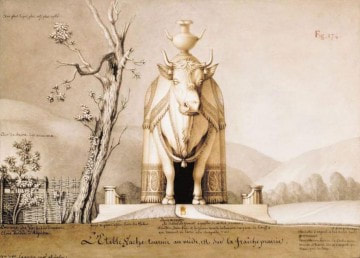ART REVIEW: "Jean-Jacques Lequeu: Visionary Architect"“Jean-Jacques Lequeu: Visionary Architect” at the Morgan Library and Museum in New York presents some 60 drawings by a French artist who went unrecognized until more than 100 years after his death in 1826. The drawings are on loan from the Bibliotheque national de France. We found the exhibition challenging and thought provoking.
Lequeu was born in Rouen in 1767. He dreamed of becoming an architect and won a scholarship to study architecture in Paris. Seemingly, on the road to success, he subsequently went to work for a prestigious architect but after the architect died, Lequeu's career went nowhere. Following the French Revolution, Lequeu entered competitions for monumental public buildings designed to honor some of the ideals of the Revolution. For example, one of his proposals was for a temple of equality. In another, the pillars of the building were made up of shackled aristocrats. Carrying forward the then-popular idea that a building's appearance should reflect its purpose, he submitted a proposal for a monumental cow barn in the shape of a giant Assyrian cow. A few of his drawings were exhibited but none of his buildings were ever built. In order to make a living, he found employment with a number of government agencies, such as the national land registry, where he could put his skill as a draftsman to work. Following the fall of Napoleon and the return of the Bourbon monarchy, he was pensioned off from the government because of his support for the Revolution. To supplement his meager pension, he attempted to sell some of his drawings. However, this too proved unsuccessful. Before his death, Lequeu donated several hundred of his drawings to the predecessor of the Bibliotheque national de France. These were all but ignored until the middle of the 20th century when they were rediscovered by the Viennese art historian Emil Kaufmann. Lequeu's work was praised as revolutionary and as a forerunner of surrealism. With regard to Lequeu's architecture, the exhibition at the Morgan presents some of the drawings that he did early in his career prior to the Revolution as well as some of the proposals that he submitted to the Revolutionary government. In addition, Lequeu also drew imaginary buildings for a fantasy world that he created. These buildings embodied elements of an array of architectural styles including Chinese, Indian and Roman. That these drawings were for his own amusement is shown by the fact that they include such things as a temple for the initiation of ancient Greek priests. Lequeu also drew people as well as buildings. The exhibition begins with a series of self-portraits in which he adopted distorted facial expressions. These would not appear out of place in an exhibition of Surrealist or Dada works. However, it is unclear whether they were meant to convey a point or are just studies of facial features. Also, Lequeu lived during a period when libertinism and investigation of sexuality were in vogue and his art includes erotic drawings. While most of the people in these drawings are disguised as ancient Greeks or Romans, he also drew contemporary figures such as a nun exposing her breasts. Entitled “And we too shall become mothers,” this drawing may have had a political meaning at the time as the Revolutionary government had dissolved the clerical orders in France. At the end of the day, Lequeu emerges as an enigmatic figure. He had imagination and he had artistic ability - - essential ingredients of good art. However, with regard to imagination, one is often left to wonder whether the work was meant as a humorous comment on the subject or whether his creativity had been sidetracked by some of the uncritical thinking of the Revolution that eventually failed in the marketplace of ideas. Was he a subtle critic of modern mores or was he simply swept along by some of the popular absurdities of his time? With regard to artistic ability, Lequeu's drawing style is very precise including meticulous detail. This is an asset in architectural drawing. However, even in his erotic drawings, there is a cold, clinical precision. Lequeu seems incapable of escaping his architectural training. He is able to render human forms but fails to capture the subject's humanity. |
"The Great Yawner" by Lequeu.
Above: Lequeu's proposal for a cow barn in the shape of cow.
Below: "And We Too Shall Be Mothers" by Lequeu. |
Art review - Morgan Library and Museum - "Jean-Jacques Lequeu: Visionary Architect"


